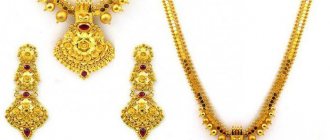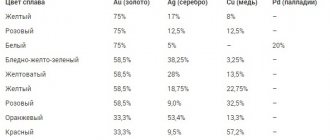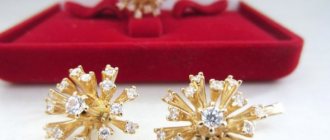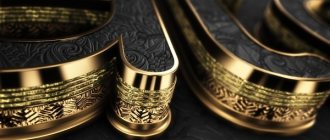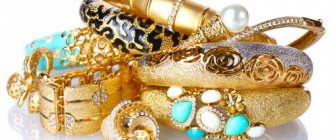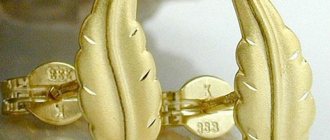Gold in history
The first metal that primitive man found was a nugget of gold. This happened back in the Neolithic period, when dishes and other household items began to be made from precious metal. The substance was used in many countries:
- Ancient Egypt;
- India;
- China;
- Roman Empire.
Many literary works contain descriptions of precious metals. Special scientists - alchemists - studied its properties.
They called gold the king of all metals. Believing societies compared it to the sun and believed that the substance was endowed with special magical and healing properties.
The chemical element was mined in large quantities in those places where the first civilizations had sites and dwellings - North Africa, Central Europe, South America. The fossil occurs in nature in the form of nuggets of different sizes. They are found both separately and as part of various substances.
In those days there were no special technologies, so gold was mined by hand. A few grams of pure material could be obtained in only 2-3 days. Extraction specialists carried out work near rivers, where they washed coastal sand using a fine sieve.
As a chemical element on the periodic table, gold is associated with many historical events and geographical discoveries. Man discovered new uninhabited territories and immediately began searching for minerals. If precious grains were embedded in the rock by nature, they were found a few days after settlement. Au is how gold is designated in the periodic table. Its name comes from the Latin language.
Imitations
They have been able to counterfeit status metal since the times of the Egyptian pharaohs. It was not difficult: gold is too similar to other metals and ores. For example, pyrite is applied to an ornamental stone. The Spanish conquistadors took it from the Indians, believing it to be gold. Prospectors from the Alaska Gold Rush fell into the same trap.
It’s not for nothing that pyrite came to be called “fool’s gold.”
More noble options: electron (an alloy of aurum with silver) and polyxene (platinum plus other components that give the alloy a golden appearance).
The following types of “gold” have been created by man:
- French – copper + tin + zinc.
- Abyssinian – copper + zinc + aurum (0.5%).
- German (goldin) – copper + aluminum.
There are other types of brass-based counterfeits: tombak, pinchback, and others.
It is impossible to distinguish such a fake on your own. Home methods - exposure to iodine, testing with a lapis pencil - allow you to identify the origin of only the surface layer.
Testing for magnetism does not always help either.
Therefore, you should buy gold jewelry from trusted sellers and not immediately tear off the tag with the seal. You can take the item to a jeweler or pawn shop for further inspection.
Nature of metal
In nature, the element of Mendeleev's periodic table - gold - is found quite often. According to geographers, 5% of the earth's lithosphere consists of this substance. Even special equipment does not make it possible to simplify the procedure for its extraction, so the cost of the metal is high. Most igneous rocks contain precious material, but it looks like gold dust.
In the earth's crust, matter is deposited due to temperature changes and many chemical processes. The formula of these grains differs from those found on the surface of rocks. Miners find nuggets in iron and mineral ores; in rare cases, gold is present in combination with substances such as:
- antimony;
- selenium;
- bismuth.
The natural element can also be found in the structure of the biosphere. It is found in compounds of living organisms and bacteria.
Small amounts of gold can be extracted even from ordinary running water. At the very beginning of geological excavations, huge deposits of metal were found under layers of earth.
About forty countries in the world are engaged in the extraction of the substance. Most are found in the CIS countries, Canada and African territories. Leaders in gold production:
- China;
- Australia;
- Russian Federation;
- Peru;
- Republic of South Africa;
- Canada;
- USA.
The precious metal is also found in Ghana, Indonesia and Mexico. These states ensure the supply of gold to the world metals market.
Geography of places attractive to prospectors. Gold-bearing rivers of Russia
You don't have to go to the Klondike to feel the spirit of the gold rush. Russia is extremely rich in placer gold.
Around the first half of the 19th century, the term “Siberian gold” appeared. The Irkutsk region and Krasnoyarsk region turned out to be rich in many gold deposits. They were discovered inside the basins of the Ob, Tom, and Yenisei rivers. Now the Siberian precious metal is the basis of the gold mining industry of the Russian Federation.
In Bashkiria, gold was discovered in the valleys of 7 rivers in the Uchalinsky region. Nuggets weighing about 16 kilograms were found here. At the moment, gold mining in these territories is not developing so actively, although it has excellent prospects.
Physical properties
The formula of the substance is characterized by plasticity and flexibility, so the metal is considered the softest among all substances in the world. It is easily processed and mechanically damaged, so products made from it are easy to damage and bend. Jewelers and cutlery makers do not use pure gold; they add other alloys for strength.
High-quality metal is suitable for the manufacture of long wires and thin plates. Such parts are necessary in electronics and industry. The main advantage of the substance is that it is highly resistant to chemical processes and reactions. Gold is considered a good conductor; it quickly transports electric current and thermal energy.
Absolutely pure metal without impurities has a characteristic bright yellow color. But such a substance is difficult to find in stores. Even bullion, which is used for investment and economic reserves, contains trace amounts of impurities. In nature, nuggets are composed of silver, nickel, copper and platinum. To improve color, jewelers can add iron oxide and manganese to gold.
The metal can be easily polished, after which it reflects light and produces a soft shine. If you make a very thin plate of the substance, it will transmit sunlight. At the same time, the temperature of the material drops rather than rises, which allows it to be used for high-quality window tinting. The sample designation indicates the content of a certain amount of material in the product.
Chemistry of matter
The substance was found much earlier than gold appeared in the periodic system. But in the table, metal has a great significance. Chemists have always tried to conduct experiments on the material, trying to turn other fossils into precious grains. Sulfur and oxygen have a bad effect on other elements from the periodic system, but gold is resistant to their effects. Only atoms on the surface of the metal exhibit a minor reaction.
The content of the material determines its characteristics and properties. With some substances, reactions occur even at room temperature, while others do not change under chemical influence when heated or decomposed into atoms. Gold is not affected by mineral acids; it is in this way that the quality of the metal is determined. In a school chemistry course they cover what gold is called according to the periodic table. Its name is Aurum, the element ranks 79th in the sixth period. Its atomic mass is 196.67, melting point is 1064.43 degrees.
Jewelers use nitric acid to verify the authenticity of products. The object is lowered into a container with liquid and left for 5-10 minutes. If the substance has not changed its color, then it is real. Fake gold will react chemically with acid and change its color to green.
Economic information
Gold plays the role of a national equivalent in the economy. With its help, the value of all goods is expressed, in some cases it becomes full-fledged money or a means of exchange. There are several physical and chemical properties that make gold stand out in the commodity world:
- divisibility;
- uniformity;
- plasticity and malleability;
- portability - significant cost with low weight;
- easy processing.
In many countries, the precious metal is used for minting coins, and its bullion is stored in banking institutions.
It is used not only in the jewelry industry, for which it was originally mined, but also for the production of some parts of electronics, industrial and household appliances. At first, the substance was used only for finishing jewelry and clothing, but in 1500 BC in China, Mesopotamia, Egypt and India it began to play the role of money. Along with gold, these functions were performed by silver and copper.
The desire to get rich pushed miners to search for new deposits. This is how many territories were discovered and colonized. Sources of the mineral were found in Europe, Asia, Africa, South and North America, and Australia. It was actively exported to developed countries - England, Spain, France, Germany. Great Britain became the first state to switch to a monometallic policy and eliminate silver coins from use. By the 20th century, this currency was approved in most world countries.
After this, a crisis of capitalism sets in, states begin to use paper money that cannot be exchanged for gold. In some territories, the export and import of metal is limited and prohibited, and special markets are being prepared to work with it. Today, many entrepreneurs and economists invest in this material and receive good profits from operations with it.
How to distinguish from a fake
You may have come across recommendations like testing gold on a tooth or scratching a product to see what’s inside. True, one can hardly imagine a seller patiently watching as a potential buyer scrapes a piece of jewelry from a display case with a penknife.
A tip from the same series is to run the product over unfired ceramics. If you managed to escape from the angry seller and saw the golden trail, then it is real.
But I suggest not to risk it and consider other methods.
- First, pay attention to the presence of markings - any product made of precious metals always has a hallmark, and its outlines must be clear.
- Secondly, make sure that the product does not have a “metallic” smell. Real metal also does not have the ability to be attracted by a magnet.
- Next, let's take a closer look at the joints. On jewelry where they are present, you can often see a difference in color; this is one of the signs of a gold product.
There are several other ways to test gold for authenticity, but they are a little extreme and are more suitable if you find the product in your home rather than purchasing it. For example, moisten the jewelry in plain water and draw a line with a lapis pencil. Counterfeit or very low-grade gold tends to leave a mark.
On the Internet, I came across the following advice: rub the product on a thick fabric, such as jeans, and drop iodine on this place. A fake or low grade can be recognized by its ability to darken. But this method seems very doubtful to me, because in this case even the 585 standard is considered low, and brass and copper can just as easily remain indifferent to testing.
By the way, vinegar can also act as a similar indicator - within five minutes spent in this liquid, a product made of another metal will darken. But you wouldn't go to a jewelry store with a bottle of vinegar, would you?
Meaning in art
From the very beginning of mining, gold has been used for the production of jewelry, ornaments, religious and palace utensils, dishes and cutlery. The softness and malleability of the metal allows it to be minted into coins, engraved on objects, casting and wire making. The substance is used to create filigree and polish surfaces, which, after treatment, will shimmer with light reflections with a rich play of light and shadow. Gold looks beautiful in combination with other materials - silver, platinum, pearls, precious stones, enamel and niello.
In medicine, the metal is contained in domestic and imported drugs: oil suspensions, crizanil, myocrisin, as well as water-soluble drugs used to prepare solutions. Medicines can cause some side effects, including kidney problems, fever, and intestinal irritation. You cannot prescribe products containing grains of gold to those who suffer from severe forms of tuberculosis, kidney and liver failure, diseases of the vascular system and diabetes.
Beta and gamma therapy involves introducing gold granules and pins into the soft tissue. It is necessary in the treatment of tumors, but only in combination with surgical and drug therapy. A preliminary diagnosis of the internal organs of the body is carried out.
Gold plays a big role in the life of mankind. It is used in many areas: economic, jewelry, medical, industrial. Precious metal has a high value due to its physical and chemical properties.



